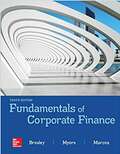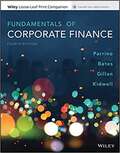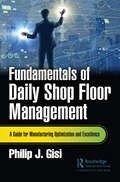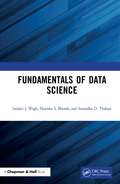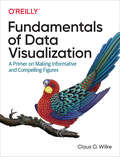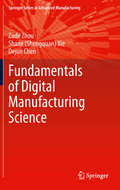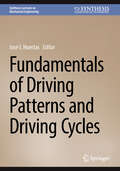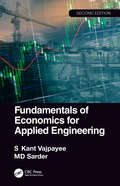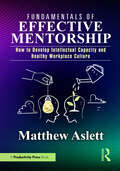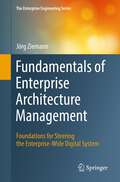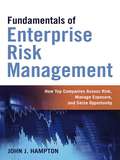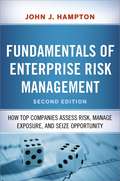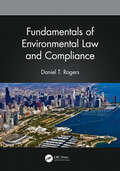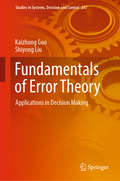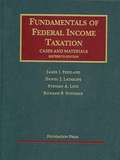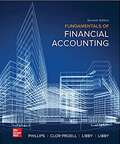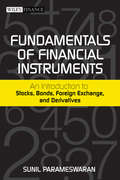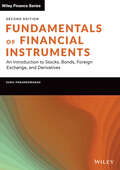- Table View
- List View
Fundamentals of Corporate Finance
by Richard Brealey Alan Marcus Stewart MyersFundamentals of Corporate Finance, 10e, is an introduction to corporate finance and focuses on how companies invest in real assets, how they raise the money to pay for the investments, and how those assets ultimately affect the value of the firm. It also provides a broad overview of the financial landscape. The book offers a framework for systematically thinking about most of the important financial problems that both firms and individuals are likely to confront. <p><p> Fundamentals is organized around the key concepts of modern finance. These concepts, properly explained, simplify the subject. They are also practical. The tools of financial management are easier to grasp and use effectively when presented in a consistent conceptual framework. This text provides that framework.
Fundamentals of Corporate Finance
by Stuart L. Gillan Robert Parrino David S. Kidwell Thomas W. BatesFundamentals of Corporate Finance ’s applied perspective cements your understanding of modern-day core principles, focusing on problem solving and real-life financial management practices—all within a clear valuation framework.
Fundamentals of Corporate Finance (U. Maryland College Park Edition)
by Jonathan Berk Peter Demarzo Jarrad HarfordCustom Edition for University of Maryland - College Park Taken from: Fundamentals of Corporate Finance, Third Edition by Jonathan Berk, Peter DeMarzo, and Jarrad Harford
Fundamentals of Daily Shop Floor Management: A Guide for Manufacturing Optimization and Excellence
by Philip J. GisiSurvival and thriving in today’s business environment require companies to continuously strive for operational excellence at all levels of the organization. Simply working to maintain existing operations is not an adequate or sustainable business strategy, especially when competing in a global market. To remain relevant, companies must adopt a process control and continuous improvement mentality as an integral part of their daily work activities. These two operational disciplines form the foundation and stepping stones for manufacturing excellence. Processes must be stable, capable, and controlled as a prerequisite for sustainable improvement. Sustainable improvements must be strategic, continuous, and focused on process optimization. Modern-day manufacturing is rapidly changing in the face of technological, geopolitical, social, and environmental developments. These challenges are altering the way we think and act to transform raw materials into finished goods. Meeting these challenges requires particular attention to how we develop and engage people and apply technology for long-term sustainability and competitive advantage. This book takes you on a journey to explore the fundamental elements, management practices, improvement methods, and future direction of shop floor management. Part 1 of this five-part manuscript considers workplace culture, organizational structure, operational discipline, and employee accountability as the foundation for a robust manufacturing system. Part 2 studies the impact of process standardization, data analytics, information sharing, communication, and people on daily shop floor management. Once the management system has been adequately described, Part 3 concentrates on its effective execution, monitoring, and control with a deep look into the people, methods, machines, materials, and environment that make it possible. Like every good manufacturing text, efficiency and productivity are key topics. That’s why Part 4 explores various methods, tools, and techniques associated with product and process development, productivity improvement, agile methods, shop floor optimization, and manufacturing excellence. The final section, Part 5, shifts focus to emerging technologies, engaging the reader to contemplate technology’s impact on the digital transformation of the manufacturing industry.
Fundamentals of Data Science
by Sanjeev J. Wagh Manisha S. Bhende Anuradha D. ThakareFundamentals of Data Science is designed for students, academicians and practitioners with a complete walkthrough right from the foundational groundwork required to outlining all the concepts, techniques and tools required to understand Data Science. Data Science is an umbrella term for the non-traditional techniques and technologies that are required to collect, aggregate, process, and gain insights from massive datasets. This book offers all the processes, methodologies, various steps like data acquisition, pre-process, mining, prediction, and visualization tools for extracting insights from vast amounts of data by the use of various scientific methods, algorithms, and processes Readers will learn the steps necessary to create the application with SQl, NoSQL, Python, R, Matlab, Octave and Tablue. This book provides a stepwise approach to building solutions to data science applications right from understanding the fundamentals, performing data analytics to writing source code. All the concepts are discussed in simple English to help the community to become Data Scientist without much pre-requisite knowledge. Features : Simple strategies for developing statistical models that analyze data and detect patterns, trends, and relationships in data sets. Complete roadmap to Data Science approach with dedicatedsections which includes Fundamentals, Methodology and Tools. Focussed approach for learning and practice various Data Science Toolswith Sample code and examples for practice. Information is presented in an accessible way for students, researchers and academicians and professionals.
Fundamentals of Data Visualization: A Primer on Making Informative and Compelling Figures
by Claus O. WilkeEffective visualization is the best way to communicate information from the increasingly large and complex datasets in the natural and social sciences. But with the increasing power of visualization software today, scientists, engineers, and business analysts often have to navigate a bewildering array of visualization choices and options.This practical book takes you through many commonly encountered visualization problems, and it provides guidelines on how to turn large datasets into clear and compelling figures. What visualization type is best for the story you want to tell? How do you make informative figures that are visually pleasing? Author Claus O. Wilke teaches you the elements most critical to successful data visualization.Explore the basic concepts of color as a tool to highlight, distinguish, or represent a valueUnderstand the importance of redundant coding to ensure you provide key information in multiple waysUse the book’s visualizations directory, a graphical guide to commonly used types of data visualizationsGet extensive examples of good and bad figuresLearn how to use figures in a document or report and how employ them effectively to tell a compelling story
Fundamentals of Database Indexing and Searching
by Arnab BhattacharyaFundamentals of Database Indexing and Searching presents well-known database searching and indexing techniques. It focuses on similarity search queries, showing how to use distance functions to measure the notion of dissimilarity.After defining database queries and similarity search queries, the book organizes the most common and representative ind
Fundamentals of Deep Learning: Designing Next-Generation Machine Intelligence Algorithms
by Nikhil Buduma Joe Papa Nithin BudumaWe're in the midst of an AI research explosion. Deep learning has unlocked superhuman perception to power our push toward creating self-driving vehicles, defeating human experts at a variety of difficult games including Go, and even generating essays with shockingly coherent prose. But deciphering these breakthroughs often takes a PhD in machine learning and mathematics.The updated second edition of this book describes the intuition behind these innovations without jargon or complexity. Python-proficient programmers, software engineering professionals, and computer science majors will be able to reimplement these breakthroughs on their own and reason about them with a level of sophistication that rivals some of the best developers in the field.Learn the mathematics behind machine learning jargonExamine the foundations of machine learning and neural networksManage problems that arise as you begin to make networks deeperBuild neural networks that analyze complex imagesPerform effective dimensionality reduction using autoencodersDive deep into sequence analysis to examine languageExplore methods in interpreting complex machine learning modelsGain theoretical and practical knowledge on generative modelingUnderstand the fundamentals of reinforcement learning
Fundamentals of Destination Management and Marketing
by Rich HarrillIACVB offers a series of stand-alone educational meetings, specific to the previously mentioned interactive learning shirtsleeves tracks, based on primary job responsibility or professional expertise. During these meetings, members convene with others in their professional area to share ideas, review programs that may or may not have worked, or discuss how to handle specific situations. The IACVB currently offers the following meetings: CEO Forum, COO/CFO Forum, Membership Shirtsleeves, Sales & Marketing Executive Forum, and Visitor Services Shirtsleeves.
Fundamentals of Digital Manufacturing Science
by Dejun Chen Shane Shengquan Xie Zude ZhouThe manufacturing industry will reap significant benefits from encouraging the development of digital manufacturing science and technology. Digital Manufacturing Science uses theorems, illustrations and tables to introduce the definition, theory architecture, main content, and key technologies of digital manufacturing science. Readers will be able to develop an in-depth understanding of the emergence and the development, the theoretical background, and the techniques and methods of digital manufacturing science. Furthermore, they will also be able to use the basic theories and key technologies described in Digital Manufacturing Science to solve practical engineering problems in modern manufacturing processes. Digital Manufacturing Science is aimed at advanced undergraduate and postgraduate students, academic researchers and researchers in the manufacturing industry. It allows readers to integrate the theories and technologies described with their own research works, and to propose new ideas and new methods to improve the theory and application of digital manufacturing science.
Fundamentals of Driving Patterns and Driving Cycles (Synthesis Lectures on Mechanical Engineering)
by José I. HuertasA driving cycles (DC) is a speed profile that represents the driving pattern of a given region or country. It is used to evaluate the vehicles energy consumption and emissions, as well as a tool to design vehicle powertrains and to evaluate strategies related energy management and logistics in several applications that involve the use of motorized vehicles. This book provides a comprehensive and general methodology to construct and assess DCs for motorized vehicles in a given region. Different techniques and methodologies for data collection and processing are presented, as well as new technologies and tendencies related to DCs are included and discussed. As an example, different case studies performed in Latin-American are presented and discussed.
Fundamentals of Economics for Applied Engineering
by S. Vajpayee Md SarderAn easy-to-follow contemporary engineering economics text that helps making sound economic decisions without advanced mathematics. <P><P>This one-semester introduction to the fundamentals of engineering economics provides an overview of the basic theory and mathematics underlying operational business decisions that engineering technology, engineering, and industrial technology students will face in the workplace. A basic knowledge of economics empowers a manager to balance costs with production. <P><P>This new edition of Fundamentals of Economics for Engineering Technologists and Engineers is written in plain language. Concepts have been simplified and kept straightforward with an emphasis on "how to apply" economic principles. <P><P>Practical examples as a tool for managing business data and giving detailed analysis of business operations. throughout the text make good use of Microsoft Excel templates, provided on the book’s companion website, for students. Chapter-end exercises provide discussion and multiple-choice questions along with numerical problems, and a solutions manual and instructor resources is given for adopting instructors.
Fundamentals of Effective Mentorship: How to Develop Intellectual Capacity and Healthy Workplace Culture
by Matthew AslettGame AI Uncovered: Volume Three continues the series with another collection of chapters from 18 of the top game AI professionals and researchers, from around the world. Each chapter includes wisdom, ideas, tips, and tricks that were used in the development of video games.The techniques discussed in these pages cover the underlying development of a wide array of published titles, including Watch Dogs: Legion, City of Gangsters, Eve: Valkyrie, Firefall, The Persistence, Advance Soccer, Alpha Beta Gunner, and Luna Abyss.Contained within this volume are insights that cover a host of different areas within game AI, including vehicle AI, simulating social norms, AI spawning fundamentals, pathfinding, creation of characters using components, animation-driven behaviour, tactical positioning in football, automated testing, abstract pattern matching, and machine learning for games.Beginners in the area of game AI, along with professional developers, will find a wealth of knowledge that will not only help in the development of their own games but also spark ideas for new approaches.This volume includes chapters written by Dr Allan Bruce, Anubha Banerjee, Bruno Rebaque, Dale Green, David Wooldridge, Eric S. Le Saux, Greg Irwin, Jason Lok Heng Chin, Johan Holthausen, John Reynolds, Mathias Siemonsmeier, Michele Condò, Dr Nic Melder, Paul Roberts, Phil Carlisle, Richard Bull, Robert Zubek, and Tobias Karlsson.
Fundamentals of Enterprise Architecture Management: Foundations for Steering the Enterprise-Wide Digital System (The Enterprise Engineering Series)
by Jörg ZiemannThis textbook provides a comprehensive, holistic, scientifically precise, and practically relevant description of Enterprise Architecture Management (EAM). Based on state-of-the-art concepts, it also addresses current trends like disruptive digitization or agile methods. The book is structured in five chapters. The first chapter offers a comprehensive overview of EAM. It addresses questions like: what does EAM mean, what is the history of EAM, why do enterprises need EAM, what are its goals, and how is it related to digitalization? It also includes a short overview of essential EAM standards and literature. The second chapter provides an overview of Enterprise Architecture (EA). It starts with clarifying basic terminology and the difference between EA and EAM. It also gives a short summary of existing EA frameworks and methods for structuring the digital ecosystem into layers and views. The third chapter addresses the strategic and tactical context of the EAM capability in an enterprise. It defines essential terms and parameters in the context of enterprise strategy and tactics as well as the operative, organizational context of EAM. The fourth chapter specifies the detailed goals, processes, functions, artifacts, roles and tools of EAM, building the basis for an EAM process framework that provides a comprehensive overview of EAM processes and functions. Closing the circle, the last chapter describes how to evaluate EAM in an enterprise. It starts by laying out core terminology, like “metric” and “strategic performance measurement system” and ends with a framework that integrates the various measuring areas in the context of EA and EAM. This textbook focuses on two groups: First, EAM scholars, ie bachelor or master students of Business Information Systems, Business Administration or Computer Science. And second, EAM practitioners working in the field of IT strategy or EA who need a reliable, scientifically solid, and practically proven state-of-the-art description of essential EAM methods.
Fundamentals of Enterprise Risk Management: How Top Companies Assess Risk, Manage Exposure, and Seize Opportunity
by John HamptonUsing examples from companies such as Home Depot, Airbus, Boeing, and Nokia, Fundamentals of Enterprise Risk Management takes a fresh look at one of the hottest topics in business today. Showing readers in charge of monitoring operational exposures in corporations, nonprofit organizations, and government agencies how they can best determine and balance opportunities against the possibilities of loss, this book provides clear strategies to help readers: • recognize both internal and external exposures • understand important concepts such as risk mapping and risk identification • recognize the weaknesses of current ERM systems • align risk opportunities with their organization’s business model • stay in line with Sarbanes-Oxley compliance The book introduces innovative new concepts such as hierarchical risk structures, alignment of risks with the business model, creation of a central risk function, and the role of an ERM knowledge warehouse. Featuring enlightening case studies and practical exercises, this essential book shows readers how they can implement ERM the right way at their organizations.
Fundamentals of Enterprise Risk Management: How Top Companies Assess Risk, Manage Exposure, and Seize Opportunity
by John J. HamptonAfter the devastation experienced by AIG, Bear Stearns, Lehman Brothers, and other financial institutions, the need for effective, comprehensive enterprise risk management (ERM) systems has never been more stark or immediate.
Fundamentals of Environmental Law and Compliance
by Daniel T. RogersThis textbook provides readers with the fundamentals and the intent of environmental regulations so that compliance can be greatly improved and streamlined. Through numerous examples and case studies, it explains concepts from how environmental laws are applied and work to why pollution prevention and sustainability are critical for the future of all life on Earth. It is organized to accommodate different needs of students with different backgrounds and career choices. It is also useful for site safety and environmental managers, researchers, technicians, and other young professionals with a desire to apply environmental regulations and sustainability measures to their facilities and stay up to date on recently changed regulations. FEATURES Introduces students to issues of global environmental and sustainability challenges and policy Explains the science behind issues such as climate change, how environmental policy is made at the national and international levels, and what role politics play in determining environmental resource use Focuses on fundamental principles that are applicable in all nations and legal contexts Addresses the planet as one biosphere and briefly discusses environmental laws and regulations of more than 50 countries Provides numerous case studies that demonstrate major concepts and themes, examples, questions, and exercises to strengthen understanding and promote critical thinking, discussion, and debate This book will benefit students in advanced undergraduate and graduate programs in environmental sciences and environmental engineering. It will also be of use to new practitioners who are entering the field of environmental management and need an introduction to environmental regulations.
Fundamentals of Error Theory: Applications in Decision Making (Studies in Systems, Decision and Control #267)
by Kaizhong Guo Shiyong LiuThis book provides a tool for generic readers and graduates who are interested or majoring in systems engineering, decision science, management science, and project management to sharpen their system thinking skills, equipping them with a multiangle perspective, and offering them broader view to understand the complex socioeconomic system in which we are embedded. It systematically investigates the root causes and mechanisms that generate errors through the use of fuzzy set theory, systems science, logic and set theory, and decision science – an area that has rarely been explored in literature. The topics covered include classic error set, fuzzy error set, multivariate error set, error function, identification of errors, error systems, error logic, error matrix, and practical application of error theory in a sewage project.
Fundamentals of Family Business System Governance
by John A. DavisReviews the purposes and ingredients in the governance (or steering) of a family business system. Explores at a high level the governance of the family business, its owners, and the family. Focuses on how these governance structures, processes, plans, and agreements interact.
Fundamentals of Federal Income Tax Law 3rd edition
by William D. PopkinWidely used text by nationally recognized scholar in tax and legislation.
Fundamentals of Federal Income Taxation 16th Edition
by James J. Freeland Daniel J. Lathrope Stephen A. Lind Richard B. StephensThis casebook provides detailed information on federal income taxation, with specific assignments to the Internal Revenue Code, selected cases, and administrative rulings from the Internal Revenue Service.
Fundamentals of Financial Accounting
by Fred Phillips Robert Libby Patricia Libby Shana Clor-ProellFundamentals of Financial Accounting uses a balanced mix of conversational wording and clear and concise presentations, allowing students to grasp concepts fundamental to financial accounting without sacrificing rigor or coverage. The authors incorporate focus companies, carefully chosen to foster student recognition and engagement, and use peer-reviewed research to inform pedagogy and presentation of concepts. This research informs the step-by-step accounting cycle model used in the text. By breaking the accounting cycle down into more cohesive, bite-sized segments, students develop a stronger foundational understanding that leads to better results in short-term assessment as well as in long-term understanding and application of the material. <p><p> New co-author Shana Clor-Proell is an associate professor at Texas Christian University. Shana has 14 years of teaching experience. She received her PhD from Cornell University. She is a CPA and previously worked as an auditor for Arthur Andersen. Fundamentals of Financial Accounting uses a balanced mix of conversational wording and clear and concise presentations, allowing students to grasp concepts fundamental to financial accounting without sacrificing rigor or coverage. The authors incorporate focus companies, carefully chosen to foster student recognition and engagement, and use peer-reviewed research to inform pedagogy and presentation of concepts. This research informs the step-by-step accounting cycle model used in the text. By breaking the accounting cycle down into more cohesive, bite-sized segments, students develop a stronger foundational understanding that leads to better results in short-term assessment as well as in long-term understanding and application of the material. <p><p> New co-author Shana Clor-Proell is an associate professor at Texas Christian University. Shana has 14 years of teaching experience. She received her PhD from Cornell University. She is a CPA and previously worked as an auditor for Arthur Andersen.
Fundamentals of Financial Accounting and Analysis
by Stephen H. BryanFundamentals of Financial Accounting & Analysis (also known as “The Green Book”) is a text that has been used with undergraduate, MBA, and Exec MBA classes. It has also been used successfully in training venues, with audiences comprised of new hires (primarily in the financial services sector) and career switchers, including medical doctors, lawyers, engineers and other professionals. It's main goal is to provide readers who have never had accounting, or who wish to update their skills and knowledge, a broad and intuitive coverage of common issues found in today's financial reporting environment. Chapters 1 and 2 introduce accounting at an overview level and introduce important terminology and concepts that form the basis for the reader's understanding of the remainder of the book. Chapter 3 introduces the need for regulatory oversight in accounting and how it applies to financial reporting. Chapter 4 covers working capital. Chapter 5 covers other asset accounts. Chapter 6 covers Liabilities and Owners' Equity. Chapter 7 is a more thorough coverage of Cash Flow Statement generation procedures and methodologies. Chapter 8 covers interaction with the global environment including foreign currency translations as well as a coverage of the difference between US and international accounting standards. Chapter 9 covers the anaylses necessary to establish the analysis of a real firm.
Fundamentals of Financial Instruments: An Introduction to Stocks, Bonds, Foreign Exchange, and Derivatives (Wiley Finance Ser.)
by Sunil ParameswaranThe essential guide to financial instruments, logically presented Fundamentals of Financial Instruments deals with the global financial markets and the instruments in which they trade. While most books on finance tend to be heavily mathematical, this book emphasizes the concepts in a logical, sequential fashion, introducing mathematical concepts only at the relevant times. As a result, the reader gains conceptual clarity reinforced by just the right level of technical detail to ensure a comprehensive exposure to the skills needed in the financial world. Establishes a strong foundation for understanding global markets Acts as an invaluable resource for those considering a career in the financial markets Offers an accessible yet in-depth treatise on modern financial instruments Presents a logical navigational path for a typical student of finance who is attempting to come to terms with the intricacies of the subject Covering the fundamentals of various types of assets in a single volume, Fundamentals of Financial Instruments is a compact yet comprehensive one-stop reference for students and professionals in finance and economics.
Fundamentals of Financial Instruments: An Introduction to Stocks, Bonds, Foreign Exchange, and Derivatives (Wiley Finance)
by Sunil K. ParameswaranIn the newly revised Second Edition of Fundamentals of Financial Instruments: An Introduction to Stocks, Bonds, Foreign Exchange, and Derivatives, renowned finance trainer Sunil Parameswaran delivers a comprehensive introduction to the full range of financial products commonly offered in the financial markets. Using clear, worked examples of everything from basic equity and debt securities to complex instruments—like derivatives and mortgage-backed securities – the author outlines the structure and dynamics of the free-market system and explores the environment in which financial instruments are traded. This one-of-a-kind book also includes: New discussions on interest rate derivatives, bonds with embedded options, mutual funds, ETFs, pension plans, financial macroeconomics, orders and exchanges, and Excel functions for finance Supplementary materials to enhance the reader’s ability to apply the material contained within A foundational exploration of interest rates and the time value of moneyFundamentals of Financial Instruments is the ideal resource for business school students at the undergraduate and graduate levels, as well as anyone studying financial management or the financial markets. It also belongs on the bookshelves of executive education students and finance professionals seeking a refresher on the fundamentals of their industry.
